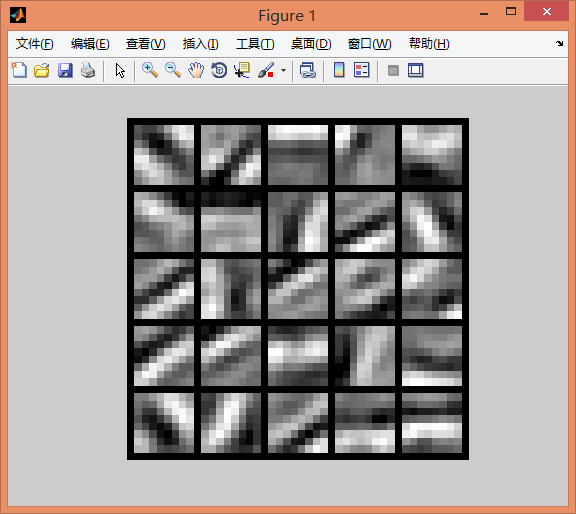UFIDL稀疏自编码代码实现及解释
1.今天我们来讲一下UFIDL的第一个练习。
1.我们来看看最难的一个.m文件
%% ---------- YOUR CODE HERE --------------------------------------
% Instructions: Compute the cost/optimization objective J_sparse(W,b) for the Sparse Autoencoder,
% and the corresponding gradients W1grad, W2grad, b1grad, b2grad.
%
% W1grad, W2grad, b1grad and b2grad should be computed using backpropagation.
% Note that W1grad has the same dimensions as W1, b1grad has the same dimensions
% as b1, etc. Your code should set W1grad to be the partial derivative of J_sparse(W,b) with
% respect to W1. I.e., W1grad(i,j) should be the partial derivative of J_sparse(W,b)
% with respect to the input parameter W1(i,j). Thus, W1grad should be equal to the term
% [(1/m) \Delta W^{(1)} + \lambda W^{(1)}] in the last block of pseudo-code in Section 2.2
% of the lecture notes (and similarly for W2grad, b1grad, b2grad).
%
% Stated differently, if we were using batch gradient descent to optimize the parameters,
% the gradient descent update to W1 would be W1 := W1 - alpha * W1grad, and similarly for W2, b1, b2.
%
% size(data, 1) % 64
% size(W1) % 25 64
% size(W2) % 64 25
% size(b1) % 25 1
% size(b2) % 64 1%样本的个数
m = size(data, 2);%前向传播
%第二层的输入值
z_2 = W1 * data + repmat(b1, 1, m);
%第二层的激活值
a_2 = sigmoid(z_2); % 25 10000%计算rho_hat的值,其值为第二层的每个维度(64)上的平均激活度,sum(a_2,2)表示对第二维求和,即对每一行求和
rho_hat = sum(a_2, 2) / m; % This doesn't contain an x because the data% above "has" the x
%第三层的输入
z_3 = W2 * a_2 + repmat(b2, 1, m);
%第三层的激活
a_3 = sigmoid(z_3); % 64 10000%激活值与实际值的差
diff = a_3 - data;%稀疏自编码的惩罚,KLdivergence(相对熵)
sparse_penalty = kl(sparsityParam, rho_hat);%简化的代价函数
%这个写的比较简洁
J_simple = sum(sum(diff.^2)) / (2*m);%正则项,即所有W元素的平方和
%这个写得也不错,W1(:)使得矩阵的元素按列重新排布
reg = sum(W1(:).^2) + sum(W2(:).^2);%总的代价
cost = J_simple + beta * sparse_penalty + lambda * reg / 2;% Backpropogationdelta_3 = diff .* (a_3 .* (1-a_3)); % 64 10000%计算残差2的基本部分
d2_simple = W2' * delta_3; % 25 10000
%计算残差2的惩罚
d2_pen = kl_delta(sparsityParam, rho_hat);%计算残差2
delta_2 = (d2_simple + beta * repmat(d2_pen,1, m)) .* a_2 .* (1-a_2);%计算b的梯度
b2grad = sum(delta_3, 2)/m;
b1grad = sum(delta_2, 2)/m;%计算W的梯度
W2grad = delta_3 * a_2'/m + lambda * W2; % 25 64
W1grad = delta_2 * data'/m + lambda * W1; % 25 64%-------------------------------------------------------------------
% After computing the cost and gradient, we will convert the gradients back
% to a vector format (suitable for minFunc). Specifically, we will unroll
% your gradient matrices into a vector.grad = [W1grad(:) ; W2grad(:) ; b1grad(:) ; b2grad(:)];end%-------------------------------------------------------------------
% Here's an implementation of the sigmoid function, which you may find useful
% in your computation of the costs and the gradients. This inputs a (row or
% column) vector (say (z1, z2, z3)) and returns (f(z1), f(z2), f(z3)). function sigm = sigmoid(x)sigm = 1 ./ (1 + exp(-x));
end%相对熵
function ans = kl(r, rh)ans = sum(r .* log(r ./ rh) + (1-r) .* log( (1-r) ./ (1-rh)));
end%相对熵的残差计算公式
function ans = kl_delta(r, rh)ans = -(r./rh) + (1-r) ./ (1-rh);
end%sigmoid函数的导数
function pr = prime(x)pr = sigmoid(x) .* (1 - sigmoid(x));
end我对上述进行了解释。
接下去是SampleIMAGES文件,这个比较简单我就不解释了
function patches = sampleIMAGES()
% sampleIMAGES
% Returns 10000 patches for trainingload IMAGES; % load images from disk patchsize = 8; % we'll use 8x8 patches
numpatches = 10000;% Initialize patches with zeros. Your code will fill in this matrix--one
% column per patch, 10000 columns.
patches = zeros(patchsize*patchsize, numpatches);%% ---------- YOUR CODE HERE --------------------------------------
% Instructions: Fill in the variable called "patches" using data
% from IMAGES.
%
% IMAGES is a 3D array containing 10 images
% For instance, IMAGES(:,:,6) is a 512x512 array containing the 6th image,
% and you can type "imagesc(IMAGES(:,:,6)), colormap gray;" to visualize
% it. (The contrast on these images look a bit off because they have
% been preprocessed using using "whitening." See the lecture notes for
% more details.) As a second example, IMAGES(21:30,21:30,1) is an image
% patch corresponding to the pixels in the block (21,21) to (30,30) of
% Image 1% imagesc(IMAGES(:,:,10)) % 1-10
% size(patches) % 64 x 10000
% size(patches(:,1)) % 64 x 1for i = 1:numpatchesx = randi(512-8+1);y = randi(512-8+1);sample = IMAGES(x:x+7,y:y+7,randi(10));patches(:,i) = sample(:);
end%% ---------------------------------------------------------------
% For the autoencoder to work well we need to normalize the data
% Specifically, since the output of the network is bounded between [0,1]
% (due to the sigmoid activation function), we have to make sure
% the range of pixel values is also bounded between [0,1]
patches = normalizeData(patches);end%% ---------------------------------------------------------------
function patches = normalizeData(patches)% Squash data to [0.1, 0.9] since we use sigmoid as the activation
% function in the output layer% Remove DC (mean of images).
patches = bsxfun(@minus, patches, mean(patches));% Truncate to +/-3 standard deviations and scale to -1 to 1
pstd = 3 * std(patches(:));
patches = max(min(patches, pstd), -pstd) / pstd;% Rescale from [-1,1] to [0.1,0.9]
patches = (patches + 1) * 0.4 + 0.1;end
接下去是计算梯度函数
function numgrad = computeNumericalGradient(J, theta)
% numgrad = computeNumericalGradient(J, theta)
% theta: a vector of parameters
% J: a function that outputs a real-number. Calling y = J(theta) will return the
% function value at theta. % Initialize numgrad with zeros
numgrad = zeros(size(theta));%% ---------- YOUR CODE HERE --------------------------------------
% Instructions:
% Implement numerical gradient checking, and return the result in numgrad.
% (See Section 2.3 of the lecture notes.)
% You should write code so that numgrad(i) is (the numerical approximation to) the
% partial derivative of J with respect to the i-th input argument, evaluated at theta.
% I.e., numgrad(i) should be the (approximately) the partial derivative of J with
% respect to theta(i).
%
% Hint: You will probably want to compute the elements of numgrad one at a time. % size(theta) 2 1 | 3289 1
% size(numgrad) 2 1 | 3289 1
eps = 1e-4;
n = size(numgrad);
I = eye(n, n);
for i = 1:size(numgrad)%通过单位矩阵来构造向量,比较有趣eps_vec = I(:,i) * eps;numgrad(i) = (J(theta + eps_vec) - J(theta - eps_vec)) / (2 * eps);
end% numgrad = (J(theta + eps) - J(theta - eps)) / (2 * eps)%% ---------------------------------------------------------------
end我们可以看到matlab的输出
可以看到我们我们通过BFGS(共轭梯度下降法),总共迭代了400次,花了51秒。
下面是稀疏自编码的结果


探讨)


)















